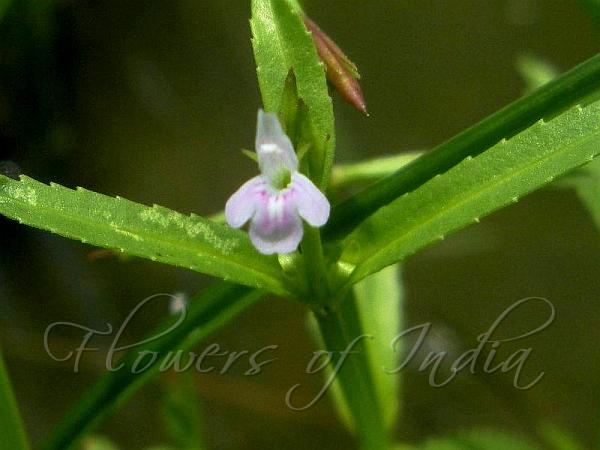|
| Opposite-Leaf Lindernia |
|

|

| File size | 105798 |
| Original date | 7/31/13 11:23 AM |
| Resolution | 800 x 600 |
| Flash | Flash did not fire, auto |
| Focal length | 6.3mm |
| Exposure time | 1/672s |
| Aperture | 3.5 |
| Focus Distance | |
| Metering Mode | Multi-segment |
| Camera make | NIKON |
| Camera model | COOLPIX S550 |
| Sensor type |
|
|
|
|
Photo: |
Botanical name: Bonnaya oppositifolia Family: Linderniaceae (Lindernia family)
Synonyms: Lindernia oppositifolia, Bonnaya minima, Vandellia oppositifolia
Synonyms: Lindernia oppositifolia, Bonnaya minima, Vandellia oppositifolia
Opposite-Leaf Lindernia is an annual herb 8-17 cm
tall. Stems are laxly branched, four-edged, erect or rising up,
hairless. Leaves are pinnately veined, stalkless, narrowly elliptic to
narrowly oblong, tip somewhat pointed to pointed, 1.1-4.2 cm long, 4-9
mm wide, margin rounded toothed-sawtoothed, with 10-18 pairs of teeth,
hairless. Inflorescence is 3-7 cm long, with 4-10 flowers, opposite
each other in most part, usually 1-2 flowers solitary in basal part of
inflorescence; each flower with a subtending bract, 3 mm long. Solitary
flower opposite to leaf-like bract in basal part of inflorescence;
flower-opposed bracts linear-elliptic, 5-10 mm long. Flower-stalks are
rising up in flower and young fruit, flower-stalks in basal part of
inflorescence deflexed in mature fruit, 4-6 mm long. Sepal-cup is
deeply 5-lobed, 2.5-4.7 mm long in flower, 3.2-4.8 mm long in fruit,
hairless. Flowers are pale mauve to pale pink, 4-8 mm long; ventral lip
with 3 rounded lobes, central lobe ~3 mm long, 4 mm wide; dorsal lip
broadly oblong, tip blunt, 3.7 mm long, 2 mm wide. Stamens are 2;
filaments 2 mm long; anther 1 mm long. Staminodes club-shaped, pale
blue to white, style 4.5 mm long. Capsule is cylindrical, tip pointed,
7-9 mm long, 1.2-2 mm wide, 2-2.2 times as long as the persistent
sepal-cup. Opposite-Leaf Lindernia is found in NE India, Bangladesh,
South India, Nepal, Sri Lanka.
| Identification credit: Aaratrik Pal | Photographed in Hooghly, West Bengal. |
• Is this flower misidentified? If yes,